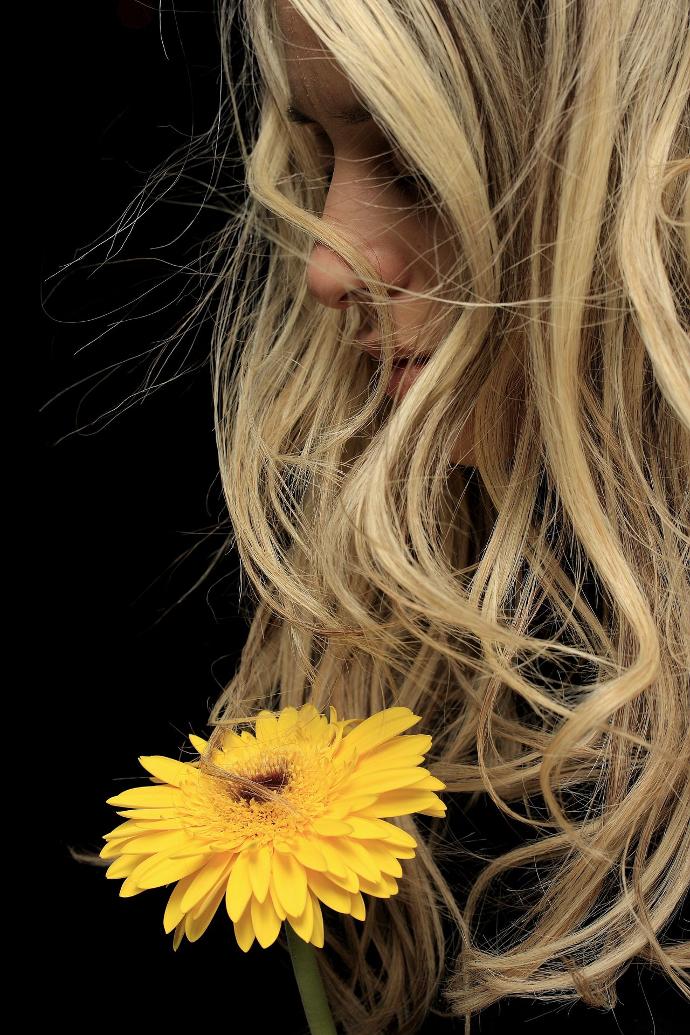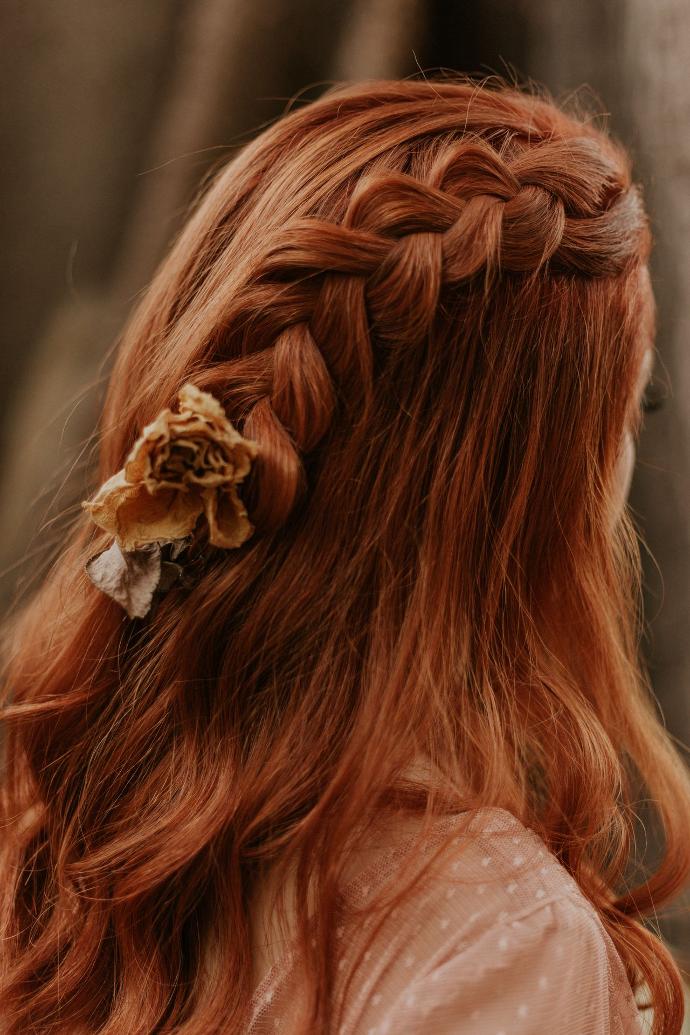Why choose plant-based hair color?
Botanical hair color, also known as natural hair color or herbal hair color, is a hair coloring method that uses natural, plant-based ingredients to dye hair. Unlike conventional hair dyes, which contain chemicals such as ammonia and peroxides, vegetable coloring uses plant extracts and vegetable powders to achieve color results.
Vegetable dyes are composed mainly of natural ingredients such as plant powders, plant extracts, herbs and vegetable oils. Commonly used ingredients include henna, indigo, walnut stain, chamomile, turmeric, hibiscus and walnut bark, among others.
Fans of vegetable color often appreciate the fact that it's gentler on the hair, as it doesn't use harsh chemicals. It can also help condition and nourish hair, giving it a healthier, shinier appearance.
It's important to note that each person may react differently to vegetable coloring due to the diversity of hair types and base colors. It is advisable to carry out a strand test or consult a qualified professional before embarking on vegetable coloring.
There are many reasons to choose plant-based hair color over traditional hair color. Here are just a few of the advantages frequently associated with the use of plant-based hair color:
-
Natural ingredients: Botanical colorants are formulated with natural ingredients, such as plant extracts, herbs and vegetable oils. They generally avoid the use of harsh chemicals, such as ammonia, peroxides and sulfates, which may be present in traditional hair colorants.
-
Gentle and respectful of hair: The natural ingredients in vegetable colorants are reputed to be gentler on hair. They can help maintain hair moisture, health and elasticity, while avoiding the damage commonly associated with the chemicals found in conventional colorants.
-
Natural, subtle color: Botanical colorants often offer more natural, subtle shades of color than chemical colorants, which can give a more vivid, artificial appearance. The shades obtained with vegetable colorings generally blend harmoniously with the hair's base color, creating a softer, more natural result.
-
White hair coverage: Although coverage of white hair can vary depending on the hair's natural color and the herbal blends used, some herbal dyes, such as henna, can provide good coverage of white hair by giving it a reddish or coppery tint.
-
Durability and gradual fading: Botanical colorations tend to be semi-permanent, meaning they last longer than ephemeral colorations, but gradually fade with each wash. This means that color can be retained for some time without the need for frequent touch-ups.
-
Reduced sensitivity: People with skin sensitivities or allergies to the chemicals found in traditional hair dyes can opt for vegetable dyes, which are often better tolerated due to their formulation with natural ingredients.

How to choose the color of your plant-based hair color?
Choosing the right color for your hair color depends on a number of factors, such as your basic hair color, your skin tone, your personal preferences and the end result you want to achieve. Here are a few tips to help you choose the right vegetable hair color:
Tenez compte de votre couleur de base des cheveux : La couleur de vos cheveux naturels influencera le résultat final de la coloration végétale. Certaines nuances fonctionnent mieux sur certaines couleurs de cheveux. Par exemple, si vous avez des cheveux blonds clairs, vous pouvez obtenir des tons de roux ou de blond plus chauds, tandis que les cheveux bruns peuvent obtenir des nuances plus foncées comme le brun ou le noir.
Considérez votre teint de peau : Votre teint de peau peut également jouer un rôle dans le choix de la couleur de votre coloration végétale. Certaines teintes peuvent compléter votre teint de manière flatteuse, tandis que d'autres peuvent créer un contraste trop prononcé. Par exemple, si vous avez un teint clair et frais, des tons de cuivre ou de roux peuvent vous convenir, tandis que les teints plus foncés peuvent opter pour des nuances plus intenses comme le chocolat ou le noir.
Test strands: Before applying color all over your hair, it's a good idea to test strands. Take a few strands of hair from an inconspicuous area and apply the vegetable color to them. This will enable you to see how the color reacts on your hair and whether it matches your expectations.
Consultez des exemples de résultats : Faites des recherches sur Internet pour trouver des exemples de résultats de colorations végétales dans la couleur que vous souhaitez. Cela peut vous donner une idée plus précise de l'apparence finale que vous pouvez obtenir.
Ask a professional for advice: If you're not sure which color to choose for your hair color, it may be a good idea to consult a qualified professional. An experienced hairdresser will be able to assess your base color and hair type, and advise you on the shades that suit you best.
How to apply vegetable color?

Step 1
Comb clean, dry hair and divide into 2 sections, securing the top. You can use a piping bag, bottle, brush or your (gloved) fingers.

Step 2
Apply the paste strand by strand, starting at the back of the head. Work through to the scalp. You can use a piping bag, an applicator bottle, a brush or your (gloved) fingers.

Step 3
Continue with the top of the head, applying thick layers strand by strand.

Step 4
Massez ;pour que l'ensemble de la chevelure soit bien couvert et regroupez l'ensemble des cheveux en un chignon.

Étape 5
Clean the area around your face and your ears, then
wrap your hair in the charlotte
Leave to set
r 1h30 to 3h
(1h30 for porous or chemically-colored hair).

Étape 6
Rinse thoroughly.
If necessary, apply a conditioner after coloring.
How to maintain your plant-based hair color
Pour conserver l’éclat de votre coloration végétale it is advisable to spacing out shampoos . Washing your hair every day can stress your scalp and damage your hair fibers . As a result, the pigments lose their intensity. The ideal is to opt for a shampoing doux formulated with ingredients of natural origin or organically grown. Classic conventional shampoos tend to accelerate color fading;
Another tip: rinse your hair with lukewarm, or even cold, water to tighten hair scales . In practice, this facilitates the absorption of nutrients and adds shine to your hair;
- Extend the radiance of your plant color
Maintaining a vegetal hair color requires a specific care routine. In addition to the use of a shampoing bio et naturel , il est recommandé d’appliquer un après-shampoing adapté . Certaines formulations à base de vinaigre de pomme préservent ainsi l’éclat de la couleur tout en démêlant les cheveux. Dans un premier temps, vous pouvez également utiliser un peigne à dents larges afin de ne pas abîmer ou casser les fibres capillaires.
- Quelle huile végétale utiliser après une coloration végétale ?
Applied regularly vegetable oil takes care of color-treated hair. In the case of vegetable coloring, it repairs and nourishes hair fibers in depth. Argan oil Argan oil, coconut oil, castor oil, sweet almond oil, avocado oil - there's something for everyone! It's up to you to choose the one that's right for you:
- castor oil densifies hair and restores volume;
- riche and vitamin E, argan oil especially for damaged hair;
- sweet almond oil provides essential nutrients for dry hair;
- jojoba oil apaise les cuirs chevelus sensibles et régule la production de sébum ;
- avocado oil renforce les fibres capillaires, tout en redonnant de la brillance aux cheveux ternes.
Cette liste est loin d’être exhaustive ! L’objectif est d’opter pour l' huile végétale qui vous convient le mieux. Pour bénéficier pleinement de ses bienfaits, il est conseillé de l’appliquer sur cheveux humides, avant de les envelopper dans une serviette chaude.
La chaleur favorise l’absorption des vitamines et de minéraux . Laissez poser une à deux heures, avant de rincer à l’aide d’un shampoing doux . Vous pouvez aussi utiliser l' huile végétale sous forme de soin à appliquer tous les jours sur les pointes.
Our tips for coloring like a pro
Here are a few tips to consider before you start coloring your hair:
- Se munir des gants.
- Avoid using metal utensils to prepare your dough.
- Protect your clothes (especially the shoulders) with an old t-shirt, for example.
- Apply henna paste to clean, dry hair.
- Apply your henna in a thick layer for deep, rich color.
- Do not wash your hair for 3 - 4 days after coloring.
- If you wish to color hair that has been chemically colored, wait 1 month after applying the chemical color before applying the vegetable color.
- After applying the paste, wrap the hair with the charlotte provided to retain heat and for added comfort. The henna paste must remain moist throughout the application;
- Lemon can have an irritating effect on sensitive scalps; a milder acid such as orange juice can be used instead.
- The final color will appear 3 to 4 days after application of your coloring paste, the time needed for the pigments to oxidize.
- Between 2 applications, you can dye your roots only.






